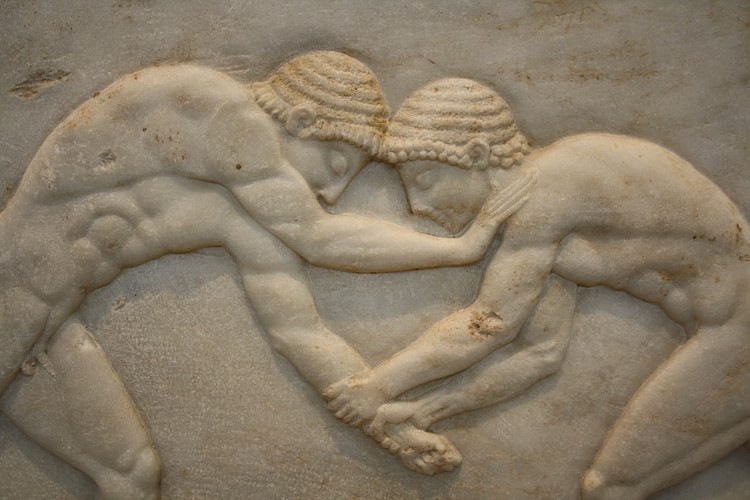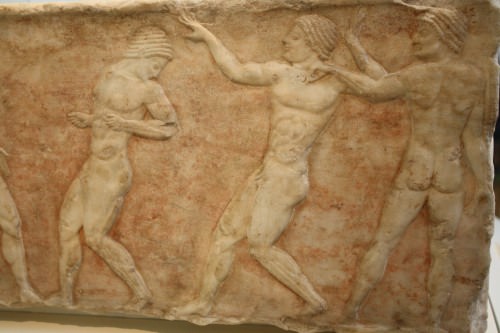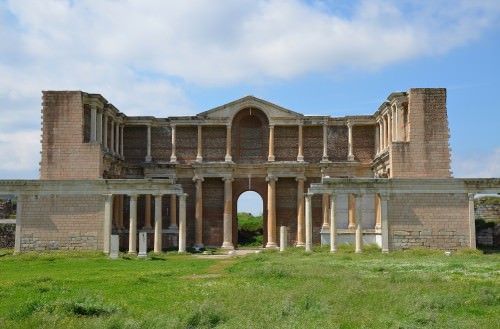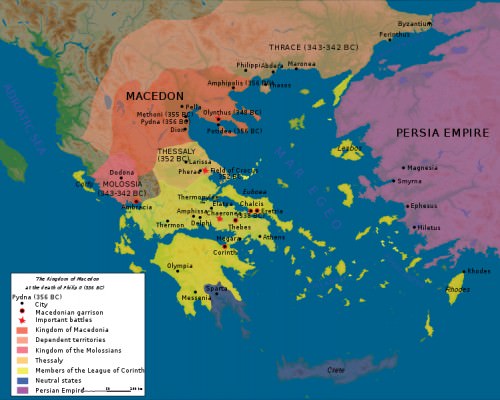Gymnasium › Phocion » Ancient origins
Articles and Definitions › Contents
- Gymnasium › Antique Origins
- Phocion › Who Was
Ancient civilizations › Historical and archaeological sites
Gymnasium › Antique Origins
Definition and Origins

The Gymnasium was a Greek building originally used for athletic activities but which came, over time, to be used also as a place of study and philosophical discussion. In the Hellenistic Period, gymnasia became highly standardized both in architecture and function and continued their important role in a young male's physical and general education. They became a common feature across the Greek world and were adopted and adapted by the later Romans, eventually evolving into the huge multi-purpose complex that was the Roman baths.
ORIGINS OF THE GYMNASIUM
The name gymnasium ( gymnasion ) derives from the Greek word for nudity ( gymnos ) as all exercise and sports were done by the male only members in the nude. The earliest recorded examples of gymnasia date to the 6th century BCE and were simple affairs consisting of an area of packed earth shaded by trees located somewhere close to a river or spring. They were especially common at sanctuary sites such as Delphi, Olympia, and Nemea.
The gymnasium may have evolved from the necessity for a dedicated space where young Greek men ( ephebeia ) could train and improve their fitness to make them ready for warfare. In battle they would fight as hoplites and so have to wear heavy bronze armour and carry a large bronze shield. Another view is that gymnasia were reserved only for the aristocracy and so came to be a place where men could demonstrate their physical, as well as their social, superiority to the lower, agricultural class.
THE TYPICAL SPORTS PRACTISED WERE WRESTLING, RUNNING, JUMPING, DISCUS, & GYMNASTICS. MANY WOULD HAVE BEEN ACCOMPANIED BY RHYTHMIC MUSIC.
The typical sports practised were wrestling, running, boxing, jumping, discus, and gymnastics. Many would have been accompanied by rhythmic music. Sports useful for warfare included archery, javelin, armed combat, and using catapults.Sports were supervised by a trainer or paidotribe, perhaps an older athlete who had gained experience at the great Games of Greece. An aleiptes was responsible for oiling and massaging members. Each year a competition might be held too, the Hermaia, where members of the gymnasium participated in a torch race and competed in three categories of events: vigor ( euexia ), discipline ( eutaxia ), and endurance ( philoponia ).
EVOLUTION OF THE GYMNASIUM
Gymnasia not only became a common feature of sanctuaries and sites famous for their sporting games but also in ordinary cities. Athens had, for example, a gymnasium at the Academy of Plato and in Aristotle ’s Lyceum. These instances illustrate that the gymnasium became a place not just for sport and young men but for men of all ages and a place where citizens might discuss the topics of the day at their leisure. They, therefore, became centres of intellectual endeavor, which even came to surpass, but never completely substitute, their function as a place of exercise. In Classical Athens, the gymnasia were, in effect, like our modern universities, where members could listen to lectures and speeches. In the Hellenistic period they changed again, becoming more like secondary schools but never losing their physical purpose where young men trained on a daily basis.

Greek Athletes
The gymnasium is frequently mentioned in literary sources, especially in Plato's dialogues. The famous philosopher describes them as a place where one of the key relationships in Greek society developed. That is between a young boy ( eromenos ) and a young man ( erastes ) where the two would become lovers and the younger party would learn from the tutoring and life experience of his elder.
By the Hellenistic Period the gymnasium had become a well-developed and much-frequented institution. One of the reasons for this was that Hellenistic rulers, conquering new territories and building new cities, wished to stamp the Greek identity on their new acquisitions and gain prestige for their city by sending athletes to do well at the various Panhellenic Games.
The Hellenistic gymnasium was run by the city and managed by a dedicated official, the gymnasiarch. A 2nd-century BCE stela from Beroia describes in greater detail his function. He was responsible for the general administration and accounting of the gymnasium and also had the power to impose fines or even physical punishment such as flogging for those members who broke the house rules. The stela goes on to describe who can attend the gymnasium – free males up to the age of 30 – and who cannot – slaves, freedmen, tradesmen, male prostitutes, drunkards, madmen, and the physically unfit ( apalaistroi ).Women are not mentioned on the list but were excluded, a point felt too obvious to mention.

The Bath, Nemea, Greece
ARCHITECTURE OF THE GYMNASIUM
By the 3rd century BCE, the gymnasiarch oversaw what was now a major architectural complex. The original exercise area had become enclosed with colonnaded buildings ( stoas ) which offered a place to sit and talk. Thus a peristyle was formed, which gave its name to the palaistra, the area specifically for wrestling. The two terms gymnasion and palaistra thus became synonymous over time. Washrooms with a supply of running cold water, bathtubs, an oiling room ( elaiothesion ), fountains, shrines, and rooms for studying were now a typical part of the complex.
Extra sporting facilities were added nearby such as a running track ( paradromis ). Sometimes there was also a covered running area, a xystos, to protect the athletes from the elements. At such cities as Pergamon and Priene, there were even full stadiums built for running, as at sporting sites such as Olympia. The gymnasium at Pergamon would become one of the largest ever built and covered around 30,000 square metres. These later gymnasia would also have had decorative sculpture and statues dedicated to the patron of the gymnasium (for example, Hercules or Hermes ), a prominent member of the city who had given funds for its maintenance, and rulers.

The Bath-Gymnasium Complex at Sardis
GYMNASIA IN THE ROMAN PERIOD
The Romans continued and developed the idea of gymnasia and, while maintaining some as centres of learning, went on to construct huge bath-houses with still the same original Greek function as a place to exercise, bathe, and study. Built on a much grander scale, these baths became focal points of city-life and benefitted from hot baths, swimming pools, libraries, and decorative art. Gymnasia continued to exist separately from baths, though, and, in many ways became a focal point for Greek cities to maintain their identity in the Roman world. Gymnasia were also positively encouraged during the reigns of philhellene emperors such as Hadrian and Antoninus. Of course, the institution survives today. The intellectual element has long gone, but that is, after all, how they started - a dedicated space for a purely physical purpose amongst the olive groves of ancient Greece.
Phocion › Who Was
Definition and Origins

Phocion (c. 402 – 318 BCE) was an Athenian statesman and military commander who, according to tradition, was made a general a staggering 45 times. A student of Plato and known as 'the Good', his political position was somewhat ambiguous, and ultimately he was accused of colluding with the Macedonians and dismantling the democracy of Athens. He is the subject of one of Plutarch ’s Lives biographies.
EARLY LIFE & CAREER
Phocion (also spelt Phokion) was born in the deme of Potamioi; his father was Phokos. Not much is known of his early life except that he studied at Plato's Academy and became a follower of the great philosopher. Amongst his friends he counted the philosopher Xenocrates and the noted general Chabrias. This distinguished company may explain Phocion's reputation as a highly principled and conservative member of the Athenian elite and his popular title of 'Phocion the Good' ( ho chrestos ). He was also famous for his austere lifestyle, and he once sent his son Phocus to Sparta so that he might benefit from their less ostentatious lifestyle compared to the aristocracy of Athens.
Phocion consistently opposed the policies of his contemporary, the famed orator Demosthenes and preferred a more pacifist policy towards the increasingly threatening Macedon. Plutarch informs us that he never sought office but accepted his duty when he was called upon. The same could be said for his policies – he would often speak his mind but bend to the decision of the government. As Plutarch quotes him, "you can make me act against my wishes, but you shall never make me speak against my judgement" (225).
PHOCION BECAME KNOWN AS THE LAST ATHENIAN STATESMAN OF GREAT STATURE & ACHIEVEMENT WHO LATER WRITERS LAMENTED AS A VICTIM OF TURBULENT & TREACHEROUS TIMES.
According to Plutarch, Phocion fought with distinction at the sea battle off rebellious Naxos in 376 BCE. His first military role, collaborated by other sources, was in 349 BCE when he was general ( strategos ) for the campaign in Euboea. This was followed by action on Cyprus, although perhaps not as a commander. Plutarch also notes in his biography that it should be remembered that by the time Phocion gained a position of power and influence, whatever he may have been accused of in his later career, the ship of state was already a wreck. Athens found itself in a period of long decline from which it would never manage to extract itself.
STRATEGOS & CHAERONEA
Famously credited with being made a strategos an impressive 45 times by ancient writers, if true, this would make Phocion the most honoured commander in Greek history. He was given the title again in 343 BCE (for the campaign in Megara ) and then followed a string of appointments. In 341 BCE he was general in Euboea again and in 340 BCE at Byzantium where he defeated Philip, capturing some of his ships and demonstrating that the great Macedonian general was not invincible after all.He commanded in 339 BCE, and again in 338 BCE and 335 BCE, the latter two illustrate Phocion's increased political stature in the aftermath of the Battle of Chaeronea (338 BCE) in which he did not participate as general, probably because of his stance not to fight the Macedonians in a battle he believed Athens could not win. In one of the most significant battles in Greek history, a combined Athenian and Theban force was defeated by Philip II of Macedon and Athenian regional dominance was permanently ended.
Phocion, made a member of the Athenian Council ( bouleutes ) in 336 BCE, was prominent in the negotiations which achieved preferential treatment for Athens amongst the Greek defeated city -states. In 335 BCE, when Alexander the Great demanded the troublesome orators Demosthenes, Lycurgus, and Hyperides be given up, Phocion recommended to the Athenians compliance and cited the example of Thebes which had invoked Alexander ’s wrath and been completely destroyed as a consequence. Plutarch credits him with later successfully negotiating an amnesty, but later historians suggest this was in fact achieved by Demades.

Macedonia under Philip II
APPEASING MACEDON
Phocion was once again made strategos, this time for four consecutive appointments from 322 BCE to 319 BCE. The first of these was during the Lamian War in Thessaly, which he had publicly opposed, between Macedon led by Alexander's successor Antipater and a combined Greek force led by Athens. Antipater won victory at Crannon and, once more, Phocion took on the role of negotiator. The result was Antipater established a garrison at nearby Munichia and Athens' constitution was amended to reduce the city's political base, in effect creating an oligarchy to replace the previous system of democracy.Phocion, considered too friendly with key Macedonians and too sympathetic to their demands, was blamed for this capitulation. In addition, Phocion helped Nicanor (the Macedonian garrison commander), or rather, considering him trustworthy he did nothing to prevent his takeover of Athens' port, the Piraeus. When Polyperchon oversaw a democratic uprising in 318 BCE, Phocion was charged with treason and condemned to death by poison as a result.
In later years Phocion's reputation would be somewhat restored, especially following the work of Demetrius of Phaleron, the Athenian statesman, and later historian and librarian at Alexandria. Phocion would thus become known as the last Athenian statesman of great stature and achievement, a man of honour and principle, who later writers such as Plutarch lamented as a victim of turbulent and treacherous times.
LICENSE:
Article based on information obtained from these sources:with permission from the Website Ancient History Encyclopedia
Content is available under License Creative Commons: Attribution-NonCommercial-ShareAlike 3.0 Unported. CC-BY-NC-SA License